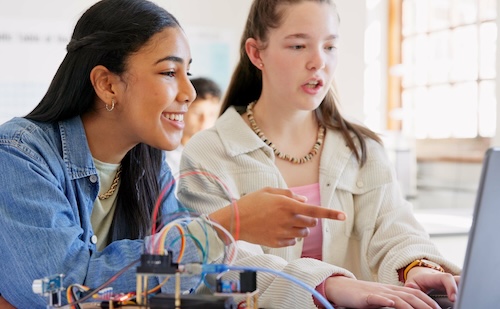Key points:
When middle school students make the leap to high school, they are expected to have a career path in mind so their classes and goals align with their future plans. That’s a tremendous ask of a teenager who is unaware of the opportunities that await them–and emerging careers that have yet to exist.
Mentors, parents, and educators spend so much time urging students to focus on their future that we do them a disservice by distracting them from their present–their passions, their interests, their hobbies. This self-discovery, combined with exposure to various career fields, fuels students’ motivation and serves as a guidebook for their professional journey.
To meet their mission of directing every student toward an individualized post-secondary plan, schools need to prioritize recognizing each student’s lifestyle goals. That way, our kids can find their best-fit career and develop greater self-awareness of their own identity.
Give students greater autonomy over their career exploration
The most problematic aspect of traditional career-readiness programs is that they’re bound so tightly to the classes in which a student excels.
For example, a high schooler on a technology track might be assigned an engineer as a mentor. However, that same student may also possess a love for writing, but because their core classes are science-based, they may never learn how to turn that passion into a career in the engineering field, whether as a UX writer, technical editor, or tech journalist.
Schools have the opportunity to help students identify their desired lifestyle, existing strengths, and possible career paths. In Aurora Public Schools in Nebraska, the district partnered with our company, Find Your Grind, an ESSA Tier 2 validated career exploration program, to guide students through a Lifestyle Assessment, enabling them to discover who they are now and who they want to become. Through this approach, teachers helped surface personalized careers, mentors, and pathway courses that aligned with students’ lifestyle goals.
Meanwhile, in Ohio, school districts launched Lifestyle Fairs, immersive, future-ready events designed to introduce students to real-world career experiences, industry mentors, and interactive learning grounded in self-discovery. Hilliard City Schools, for example, welcomed more than seventh-grade students to a Lifestyle Fair this past May.
Rather than rely on a conventional booth-style setup, Hilliard offered interactive activations that centered on 16 lifestyle archetypes, including Competitor, Explorer, Connector, and Entrepreneur. The stations allowed students to engage with various industry leaders and participate in hands-on activities, including rocket launch simulations and creative design challenges, to ignite their curiosity. Following the Fair, educators reported increased student engagement and a renewed enthusiasm for learning about potential career paths.
Create a fluidity path for future success
According to the World Economic Forum, by 2030, 97 million jobs will be displaced by AI, significantly impacting lower-wage earners and workers of color. At the same time, 170 million new jobs are expected to be created, especially in emerging fields. By providing students more freedom in their career exploration, educators can help them adapt to this ever-changing 21st-century job market.
Now is the time for school districts to ensure all students have access to equitable career planning programs and work to close societal disparities that hinder professional opportunities. Instead of setting students on a predetermined pathway toward a particular field–which may or may not exist a decade from now–educators must equip them with future-proof and transferable core skills, including flexibility, initiative, and productivity, in addition to job-specific skills. As the job market shifts, students will be prepared to change direction, switch jobs, and pivot between careers.
In Hawaii, students are taking advantage of career exploration curriculum that aligns with 21st-century career and technical education (CTE) frameworks. They are better prepared to complete their Personal Transition Plans, which are required for graduation by the state, and have access to micro-credentials that give them real-world experience in different industries rather than one particular field.
For decades, career planning has placed students in boxes, based on what the adults in their lives expect of them. Ensuring every child reaches their full professional potential means breaking down the barriers that have been set up around them and allowing them to be at the center of their own career journey. When students are empowered to discover who they are and where they want to be, they are excited to explore all the incredible opportunities available to them.












